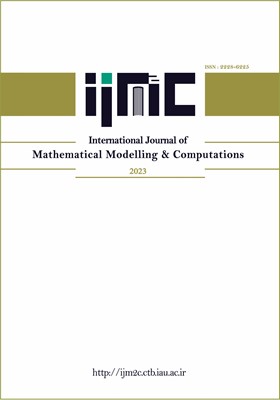Presenting a Novel Sensitivity-Damage Feature for Damage Detection Using Time-Series Analysis, Output-Only Ambient Vibration Data
Subject Areas : International Journal of Mathematical Modelling & Computations
Seyed Arman Hashemi
1
![]() ,
Behnam Adhami
2
*
,
Behnam Adhami
2
*
![]() ,
Ali Golsoorat Pahlaviani
3
,
Ali Golsoorat Pahlaviani
3
1 - Civil Engineering Department, Faculty of Civil & Earth Resources Engineering, Islamic Azad University Central Tehran Branch, Tehran
2 - Assistant Professor, Civil Engineering Department, Faculty of Civil & Earth Resources Engineering, Islamic Azad University Central Tehran Branch, Tehran, Iran
3 - Assistant Professor, Civil Engineering Department, Faculty of Civil & Earth Resources Engineering, Islamic Azad University Central Tehran Branch, Tehran, Iran.
Keywords: Damage identification, Benchmark structure, Damage-sensitivity feature, Ambient loads,
Abstract :
This paper presents a damage identification method for a benchmark structure model using time series analysis of output-only ambient vibration data. To demonstrate the capability of the proposed method, a 3D finite element model based on a benchmark laboratory model is simulated, and a novel damage-sensitivity feature based on autoregressive time series models with exogenous input (ARX) using the output acceleration responses from the sensors. , is presented under the influence of ambient loads in modeling. In the finite element model, minor local damages near the supports that may occur to a bridge during operation are created to demonstrate the robustness and stability of the proposed damage feature. The results showed that the presented damage feature could effectively identify and locate the minor damages made near the supports (which is presented as a challenge in identification studies) accurately and without errors and provide an indication of the extent of the damage.
[1] ABAQUS version 2017. Providence, RI, Dassault Systèmes Simulia Corp, (2016).
[2] M. R. Azim and M. Gul, Damage detection of steel girder railway bridges utilizing operational vibration
response, Structural Control and Health Monitoring, 26 (2019) e2447.
[3] J. L. Burkett, Benchmark Studies for Structural Health Monitoring Using Analytical and Experimental Models,
Electronic Theses and Dissertations, 436 (2005).
[4] R. Farrar and K. Worden, An introduction to structural health monitoring, Philosophical Transactions of the
Society A, 365 (2007) 303–315.
[5] S. D. Fassois and F. P. Kopsaftopoulos, Statistical Time Series Methods for Vibration Based Structural Health
Monitoring. In: W. Ostachowicz and J. Güemes (eds), New Trends in Structural Health Monitoring, CISM
International Centre for Mechanical Sciences, Springer, Vienna, 452 (2013) 209–264,
doi:10.1007/978-3-7091-1390-5_4.
[6] S. D. Fassois and J. S. Sakellariou, Statistical time-series methods for structural health monitoring, John Wiley
& Sons Ltd, (2009) 443–472.
[7] S. D. Fassois and J. S. Sakellariou, Time series methods for fault detection and identification in vibrating
structures, Philosophical Transactions of the Royal Society: Mathematical, Physical and Engineering Sciences,
365 (2007) 411–448.
[8] M. Gul and N. Catbas, Damage assessment with ambient vibration data using a novel time series analysis
methodology, Journal of Structural Engineering, 137 (12) (2011) 1518–1526.
[9] M. Gul and N. Catbas, Statistical pattern recognition for structural health monitoring using time series
modeling: Theory and experimental verifications, Mechanical Systems and Signal Processing, 23 (7) (2009)
2192–2204.
[10] M. Gul and N. Catbas, Structural health monitoring and damage assessment using a novel time series analysis
methodology with sensor clustering, Journal of Sound and Vibration, 330 (2011) 1196–1210.
[11] M. Haghani Chegeni, M. K. Sharbatdar, R. Mahjoub and M. Raftari, A novel method for detecting structural
damage based on data-driven and similarity-based techniques under environmental and operational changes,
Numerical Methods in Civil Engineering, 6 (4) (2022) 16–28.
[12] N. Johnson, Global and Local Structural Health Monitoring Methods Based on Wireless Telemetry and
Boundary-based Thermography, University of Michigan, Ph.D. Dissertation, (2017).
[13] Y. Lu and F.Gao, A novel time-domain auto-regressive model for structural damage diagnosis, Journal of
Sound and Vibration, 283 (2005) 1031–1049.
[14] L. Mei, A. Mita and J. Zhou, An improved substructural damage detection approach of shear structure based on
ARMAX model residual, Structural Control and Health Monitoring, 23 (2016) 218–236.
[15] P. G. Michaelides, P. G. Apostolellis and S. D. Fassois, Vibration–based damage diagnosis in a laboratory
cable–stayed bridge model via an RCP–ARX model based method, Journal of Physics Conference Series,
Journal of Physics: Conference Series, 305 (2011) 012104.
[16] A. J. Modesto, R. Birgul, R. J. Werlink and F. N. Catbas, Damage detection of composite overwrapped pressure
vessels using ARX models, International Journal of Pressure Vessels and Piping, 192 (2021) 104410.
[17] K. Nair, A. Kiremidjian and K. Law, Time series-based damage detection and localization algorithm with
application to the ASCE benchmark structure, Journal of Sound and Vibration, 291 (2006) 349–368.
[18] M. Pastor and M. Binda and T. Harcarik, Modal Assurance Criterion, Procedia Engineering, 48 (2012) 543–
548.
[19] H. Sohn and C. R. Farrar, Damage diagnosis using time series analysis of vibration signals, Smart Materials
and Structures, 10 (2001) 446–451.
[20] J. K. Vandiver, A. B. Dunwoody, R. B. Campbell and M. F. Cook, A mathematical basis for the random
decrement vibration signature analysis technique, Journal of Mechanical Design, 104 (2) (1982) 307–313.
[21] R. Vasheghani Farahani and D. Penumadu, Damage identification of a full-scale five-girder bridge using
time-series analysis of vibration data, Engineering Structures, 115 (2016) 129–139.
[22] K. Worden, G. Manson and N. R. J. Fieller, Damage detection using outlier analysis, Journal of Sound and
Vibration, 229 (3) (2000) 647–667.
[23] L. Xie and A. Mita, An innovative substructure damage identification approach for shear structures based on
ARMAX models, Procedia Engineering, 188 (2017) 119–124.
[24] Z. Xing and A. Mita, A substructure approach to local damage detection of shear structure, Structural Control
and Health Monitoring, 19 (2012) 309–318

